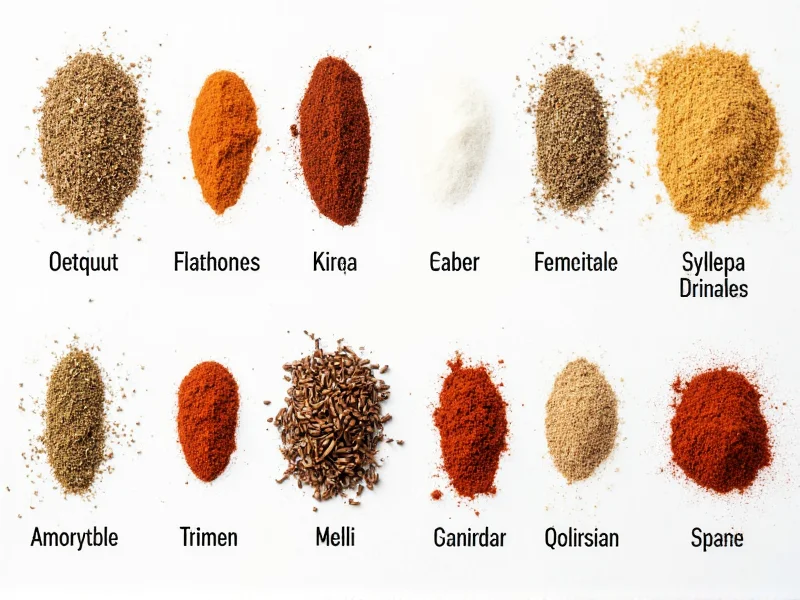Spices transform ordinary ingredients into extraordinary dishes through their complex flavor profiles and aromatic properties. Understanding the diverse world of spices empowers home cooks and professional chefs alike to create authentic, flavorful meals that reflect global culinary traditions. This definitive guide explores the most commonly used spices, their origins, flavor characteristics, and practical applications in everyday cooking.
Understanding Spice Categories
Spices can be broadly categorized by their botanical origins and physical forms. Whole spices generally retain their potency longer than ground varieties, while seed spices often require toasting to release maximum flavor. Familiarizing yourself with these categories helps in selecting the right spice for specific culinary applications and understanding proper storage techniques.
Essential Spice Reference Guide
Below is a curated selection of the most versatile and commonly used spices worldwide, organized by category for easy reference. This list focuses on spices with broad culinary applications rather than regionally specific varieties that may be difficult to source.
| Spice Name | Origin | Flavor Profile | Common Culinary Uses | Storage Duration |
|---|---|---|---|---|
| Cumin | Mediterranean/Middle East | Earthy, warm, slightly peppery | Tacos, chili, curry, hummus | 2-3 years (whole), 1-2 years (ground) |
| Turmeric | South Asia | Earthy, slightly bitter, peppery | Curries, rice dishes, golden milk | 2-3 years (whole), 1-2 years (ground) |
| Cinnamon | Sri Lanka | Sweet, warm, woody | Baking, oatmeal, chai, Moroccan tagines | 3-4 years (sticks), 1-2 years (ground) |
| Paprika | Hungary | Varies from sweet to smoky to hot | Goulash, deviled eggs, rubs, soups | 1-2 years |
| Ginger | Southeast Asia | Spicy, warm, slightly sweet | Stir-fries, baked goods, teas, marinades | 3-4 years (whole), 1-2 years (ground) |
Building Your Core Spice Collection
When establishing your foundational spice collection, prioritize versatility and shelf stability. The "Holy Trinity" of universal spices includes cumin for earthy depth, cinnamon for sweet applications, and black pepper for everyday seasoning. These three spices appear in over 80% of global recipes according to culinary research. Expand your collection gradually based on the cuisines you cook most frequently—Mexican cooking benefits from oregano and chipotle powder, while Indian cuisine requires cardamom and coriander.
Identifying Quality Spices
Fresh spices exhibit vibrant color and strong aroma when rubbed between fingers. Dull color and weak scent indicate diminished potency. Purchase spices from retailers with high turnover to ensure freshness, and consider buying whole spices then grinding them as needed using a dedicated coffee grinder. Specialty spice merchants often provide harvest dates, allowing you to select the freshest available product. Avoid "gourmet" blends with excessive fillers—pure spices contain only the named ingredient without anti-caking agents or preservatives.
Practical Spice Applications
Different cooking techniques maximize spice potential. Blooming spices in hot oil (tempering) releases essential oils and intensifies flavor, while adding ground spices late in cooking preserves volatile compounds. Whole spices work best in long-simmered dishes like stews and braises, while ground varieties integrate more readily into quick-cooking recipes. For baking, mix ground spices thoroughly with dry ingredients to ensure even distribution. When experimenting with unfamiliar spices, start with ¼ teaspoon per serving and adjust to taste.
Optimal Spice Storage Practices
Proper storage significantly extends spice shelf life. Keep spices in airtight glass or metal containers away from heat sources and direct sunlight. The ideal storage temperature is below 70°F (21°C). Avoid storing spices above the stove or near the oven, as repeated heat exposure degrades flavor compounds. Whole spices maintain potency for 3-4 years when properly stored, while ground varieties last 1-2 years. Label containers with purchase dates and periodically test spices by rubbing a small amount between your palms—if the aroma is weak, it's time to replace them.
Global Spice Traditions
Culinary traditions worldwide have developed distinctive spice combinations that define regional cuisines. Garam masala blends warm spices for Indian cooking, while Chinese five-spice combines sweet and savory elements. Ras el hanout represents North African complexity with up to 30 ingredients, and herbes de Provence captures Mediterranean herbaceous notes. Understanding these traditional blends provides insight into authentic flavor profiles and helps recreate dishes with cultural accuracy. When exploring international recipes, research the specific spice blend rather than substituting individual components for best results.











 浙公网安备
33010002000092号
浙公网安备
33010002000092号 浙B2-20120091-4
浙B2-20120091-4